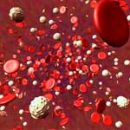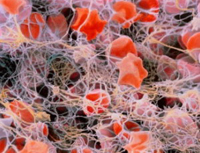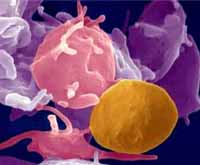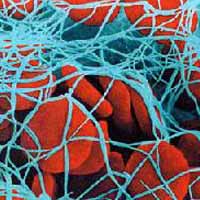Family thrombocytosis in most cases is manifested in childhood and is due to a violation in the genetic apparatus. The disease is transmitted from parents to children. In the treatment of thrombocytosis, cytostatic drugs are used, as well as antiagregants that destroy the blood clots.
Content
Concept of family thrombocytosis
Family thrombocytosis were described in childhood people. This disease relates to primary thrombocytosis associated with either anomaly in the genetic apparatus or from any other yet by an unknown cause. The transfer of family thrombocytosis can be carried out autosomal dominant, autosomal-recessively or be associated with X-chromosome. With an autosomal dominant type of inheritance for the development of the disease, it is enough to inherit a mutant allele gene from one of the parents. With an autosomal-recessive type of inheritance, the disease is manifested only in homozygotes - the body, in the hereditary set of which homologous chromosomes carry the same form of this gene. When inherited by the X-chromosome associated with an abnormal gene, admired with the X chromosome, is transmitted from parents to children. In this case, the disease is almost always manifested in men, women only get a mutant gene and transmit it to their offspring.
Mechanism of the development of thrombocytosis
The evolution of these family thrombocytosis is still little known yet. However, this thrombocytosis variant differs from the primary thrombocytosis, significantly smaller hemostatic complications (thrombotic or hemorrhagic) in children.
Treatment and prevention of thrombocytosis
 The testimony for treatment is required to be discussed with each member of a family affected by this ailment, depending on the presence of additional risk of thrombosis (vascular pathology, heart disease, the availability of testimony to bed regime, as well as biological factors predisposing to thrombosis). A lot of important role in the treatment of thrombocytosis plays the amount of platelets and the tolerance of the disease to treatment.
The testimony for treatment is required to be discussed with each member of a family affected by this ailment, depending on the presence of additional risk of thrombosis (vascular pathology, heart disease, the availability of testimony to bed regime, as well as biological factors predisposing to thrombosis). A lot of important role in the treatment of thrombocytosis plays the amount of platelets and the tolerance of the disease to treatment.
Treatment of thrombocytosis is carried out by myelosan, myelobromol and other cytostatic drugs for several weeks before normalizing the number of platelets. With disorders in the microcirculatory line, antiagregants are prescribed (acetylsalicylic acid, Trental and DR.). Antiagregants - substances that oppress the process of platelet aggregation and red blood cells, that is, reduce their ability to gluing and sticking to the vascular wall. Reducing the surface tension of the erythrocyte membranes, they facilitate their deformation when passing through the capillaries and improve «fluidity» blood. Antiagregants are capable not only to warn the aggregation, but also cause a disaggregation of already aggregated blood plates. Apply them to prevent the formation of thrombus.
In some cases, thrombocytosis can flow for a long time without pronounced external symptoms (with a small thrombocytosis and without thrombohemorgic complications), while not required treatment. The forecast in this case is relatively favorable.
Introduction The prevention of thrombosis aspirin requires discussion with respect to each patient depending on the violations of platelet aggregation.









